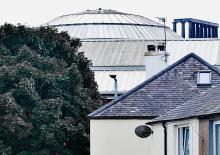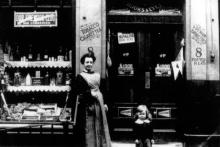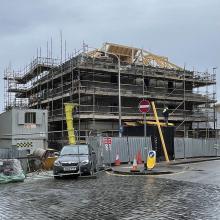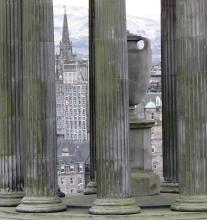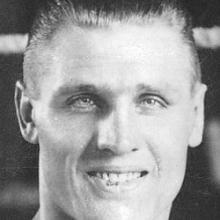
The final round
We now enter the last days of the Industrial Hall, Edinburgh’s first purpose-built exhibition space on Annandale Street.
No amount of roller-skating stunts, Christmas carnivals, circus troupes, galloping Cossacks and smoke-shrouded boxing collisions could disguise the fact that Scotland’s economy in the postwar Depression of the early and mid 1920s could not sustain a commercial venture of this kind.
Edinburgh’s public-transport sector, keen not to cramp the style of private enterprise but eager to expand, sensed an opportunity too good to pass up.
BOXING.
COOK DISQUALIFIED.
BIG FIGHT IN EDINBURGH.
In the Industrial Hall, Edinburgh, last night, before 10,000 spectators, Phil Scott [pictured], of London, British heavy-weight boxing champion, beat George Cook, of Australia, in a twenty rounds contest for the heavy-weight championship of the British Empire, Cook being disqualified in the seventeenth round for holding. The fight proved a disappointment, little real boxing being shown, because Cook held continually, and had to be cautioned repeatedly by the referee.
In addition to the big fight, which was for a purse of £1500, the promoter, Mr David Smith, of Aberdeen, staged a bout between Elky Clark, of Glasgow, the British and European fly-weight champion, and L. M. Tarrant, of London, over twenty rounds at 8st. 2 lb. Clark won easily, Tarrant retiring at the end of the tenth round.
The meeting of the two world-famous heavyweights attracted boxing enthusiasts to the Industrial Hall from all parts of the country. Scott, who was thought by many to be Britain's likeliest challenger for the world's heavy-weight honours, some time ago gained a points decision over Cook. Since then the Australian has visited the United States, where he met with considerable success. Before the championship fight began, Boy M'Cormick, of Manchester, entered, the ring and challenged the winner.
—Scotsman, 28 January 1926
BOXING.
FRENCHMEN IN EDINBURGH.
JOHNNY BROWN BEATEN.
FIVE contests between French and British boxers were staged in the Industrial Hall, Edinburgh by Mr David Smith of Aberdeen, on Saturday night. The only French success was the defeat of Johnny Brown, of Hamilton who was beaten on points over fifteen rounds by Yvan Laffineur. The attendance was disappointing, less than 3000 spectators being present.
—Scotsman, 15 March 1926
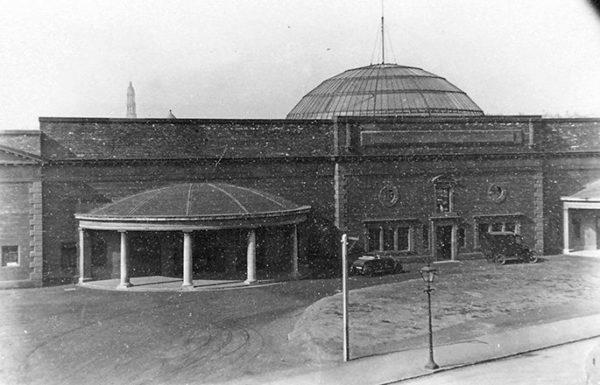
Image courtesy of Lothian Buses
EDINBURGH BUSES.
GARAGE PROBLEM.
INDUSTRIAL HALL SCHEME.
Proposals for the purchase of the Industrial Hall and the conversion of the old M’Donald Road Power Station for the purposes of a garage for Edinburgh motor buses were considered by the Tramway Committee of the Corporation yesterday. By six votes to five, it was decided to recommend to the Town Council the purchase of the Hall. Councillor Goalen, convenor of the Committee, and Councillor Herbert Lindsay, vice-convenor, moved the purchase proposal, and the direct negative was put forward by Bailie Mancur and Councillor Baxter.
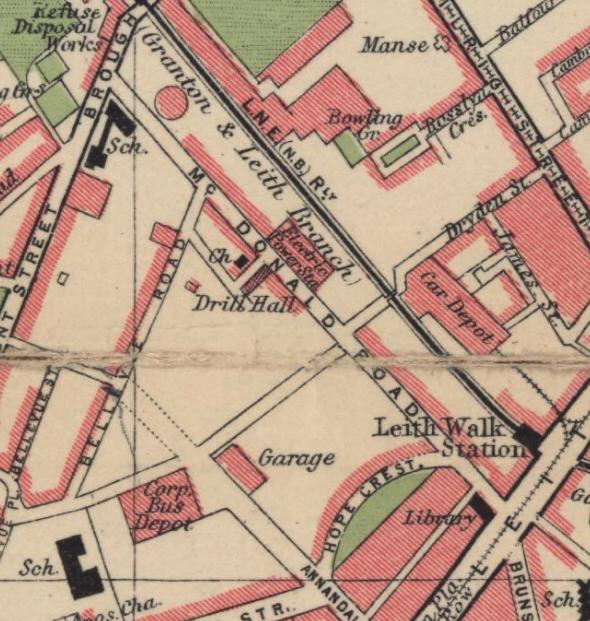
Batholomew's Pocket Plan of Edinburgh, 1926.
TRAMWAY MANAGER’S REPORT.
In a report on accommodation for motor vehicles, Mr R. S. Pilcher, the Edinburgh Corporation tramway manager, states that the total number of motor vehicles garaged by the Tramways Department is 145. These consist of 103 motor buses and 42 motor lorries and miscellaneous motor vehicles.
There aro two garages in use at present—one at Henderson Row, which is capable of housing 37 buses, and one in Lower Shrubhill Yard, which is capable of holding 57 buses. They are, however, congested, and at night are full up to the doors. It would be advisable to have more garage accommodation, so that there would be more space for manoeuvring when taking buses in and out of the depot.
In addition to the two main garages, there is a covered shed in Shrubhill capable of holding 7 lorries, whilst there are additional garages for the use of the city motor cars. There is at present a shortage of accommodation for 6 buses. When the 15 new vehicles aro delivered this will be increased to 21.
It is advisable, says Mr Pilcher, to immediately provide increased garage accommodation for motor vehicles—not only for those contracted for, but also to give greater facilities in the existing garages and provide for extensions in the future.
There are three proposals which may be considered, viz.: —( 1 ) M’Donald Road Power Station Boiler House—This building would only provide for 22 motor buses. It has rather a difficult entrance, and there would be insufficient space to permit of vehicles being turned round. ( 2 ) New Garage, M’Donald Road—The second proposal is the erection of a new garage on the vacant site adjoining M’Donald Road Power Station, which is adjacent to Shrubhill, and which is at present used as a coal bing by the electricity department. The proposal with regard to this ground is that a garage to accommodate 40 buses should be erected, the cost of which is estimated by the City Architect at £18,000. It is also proposed that at a later period, a second building to accommodate another 40 buses be erected at a further cost of £18,000.
INDUSTRIAL HALL ADVANTAGES.
The third proposal, Mr Pilcher continues, is the acquisition of the Industrial Hall. The area of this hall is 10,000 square yards, which is nearly twice the size of the site at M’Donald Road. The available accommodation would house at least 120 buses. There would be plenty of manoeuvring space, while there is ample provision for offices, messrooms, stores. &c.
It may be said that the building is too large, and that it could not be economically used by the Tramways and Motor Departments. The answer to this is that the traffic in Edinburgh has been increasing during the last few years at the rate of sixteen millions per annum, and buildings, stores, workshops, &c. are continually requiring to be enlarged to cope with the ever-increasing business. It is better to have more than the actual requirements at first than to be continually enlarging buildings, which may be much more costly in the end.
If such a building as the Industrial Hall were acquired, it would be possible to retain Shrubhill garage as a workshop, and transfer all the buses from this depot to the new building. There is, however, another and still more important reason why the acquisition of the Industrial Hall should be considered. The Gorgie car shed has just been completed. It holds 60 tramway cars, and cost £31,706, which works out at the rate of £528 per car. This accommodation is not fully taken up, but it soon will be, and it will then be necessary to acquire a new site for another shed.
ENTRANCE FROM BROUGHTON STREET.
The Industrial Hall is in every way suitable for the accommodation of tramway cars as well as motor buses. The roof is sufficiently high, and the formation of the hall is quite suitable for arranging tramway lines. An entrance to the hall could be made from Broughton Street, which is nearer to it than Leith Walk. In these circumstances the hall appears to be suitable either for a motor garage or a tramway car shed. It would accommodate at least 120 buses, or alternatively 72 buses and 70 tramway cars. The value of the accommodation when utilised would be 120 buses at £450 per bus, equals £54,000; or, if the building were used both for buses and cars, 72 buses at £ 450 per bus equals £32,400, and 70 tramcars at £528 per tram, equals £36,960—a total of £69,360. I have no doubt that in a few years the whole of this accommodation will be required, and, in my view, it would be a more economical proposition to acquire this hall than to erect a new building.
—Scotsman, 27 March 1926
INDUSTRIAL HALL PURCHASED.
Mr Goalen, Convener of the Tramway Committee, moved approval of the Committee's recommendation to purchase the Industrial Hall at a price of not more than £30,000. He said that for some months past the tramway manager had been exercising his mind as to what he should do for more bus accommodation.
At the present time they had a bus garage at Henderson Row which held 33 buses, and the Shrubhill depot held 37, with some extra accommodation in temporary buildings. Shrubhill was not a very suitable place for a garage. They had eleven bus routes at the present time, and this year the mileage had increased by 218,000 miles. The total mileage for the whole year was estimated at 2,000,000 miles, and the increase of the passengers was 1,988,145.
It was quite true that last year and the previous year they had deficits on the buses. This year, he was glad to say, there would be no deficits of £6,000. At the moment they were £800 down, but they had two good months still to come, and they expected to finish the year with a small profit, and, if not, a very small deficit.
If they erected a garage on the vacant ground at the M’Donald Road depot and covered only half the ground at the present time 40 buses would be housed, at an estimated cost of £18,000. If they covered the whole area they would get accommodation for 80 buses, and the cost would be roughly £32,000.
As to the Industrial Hall they could get possession in a few months. It was imperative that they should get accommodation at once. They were satisfied now that a good job was made of the Industrial Hall when it was built. The building would hold 120 buses and if necessary they could use it as a car depot as well.
The Tramway Committee were of opinion that the time had come when they should scrap some of the outside depots they had, such as Henderson Row, which could be sold. Economies would be effected if they had one great central garage. One staff would do the work, and only one heating installation would be required. They had an option on the hall at £30,000, and he regarded it as the biggest bargain the city of Edinburgh had ever got, or probably ever would get. The Henderson Row depot was valued at £10,000 and that would go towards the price of the Industrial Hall.
Mr Herbert Lindsay, in seconding, asked the Town Council to view this entirely from the financial aspect. At the present time they had 80 buses, and when those on order came forward they would be able to fill the hall almost straight away. The Tramway Committee did not wish to go against private enterprise whatsoever, and he would not like the members to think that they were trying to oust anybody.
M’DONALD ROAD SITE.
Bailie Mancur, in moving disapproval, said this was the recommendation of six to five members of the Tramway Committee. Urging that use should be made of the vacant ground at the electricity power station at M’Donald Road, he said that for many years the Electricity Committee had been paying a feu of £190 for ground which was used to store coal, and, surely a proper transfer could be effected between the two departments.
This was an ideal site for a garage, in close proximity to Shrubhiil depot and workshops, and connected by a railway Bridge. There was a joint responsibility on both the Electricity Committee and the Tramway Committee to take advantage of this particular occasion to utilise that ground, and complete an ugly corner. He was assured that the Industrial Hall was capable of holding 250 to 280 buses. When were they likely to require 250 buses? That was looking ahead with a vengeance.
This particular site at M’Donald Road could be utilised for 40 or 50 buses, and they were given a price of £18,000, but the comparable figure was £15,000 against the £30,000 for the Industrial Hall. Thousands of pounds had been spent at Shrubhill, Henderson Row, Tollcross, Portobello, and Gorgie. Surely they were not going to scrap those depots. They should not go forward in this extravagant manner. They had got to use what they had in hand just now! The Industrial Hall might be an ideal site, but the Tramway Committee could not afford it.
GARAGE BY STOREYS.
Mr Baxter, in seconding the amendment, said that all the bus accommodation could be got at Shrubhill. The day was past for taking valuable ground in the centre of the city in the way proposed, when other people were putting their motors on second and third fioors. They could add one or two more floors to the Shrubhiil garage, and that would be the most economical proposition.
He did not want to see municipal enterprise running to oppose private enterprise, which was serving the people as well as in any other part of the country. They should extend their tramways if there was traffic for them at all.
Mr M'Laren supported the purchase of the Industrial Hall, which, he said, was a bargain at £30,000. They had not a single bus in 1919, and now they had 88, and another 15 on order.
Mr Walker pointed out. that the Electricity Committee might require the old plant in the next winter or two. He objected to the proposal put forward in regard to M’Donald Road, and said that the subjects could be sold better as a whole. They were not in a position to sell the property. Mr Allan moved for recommittal, and pointed out that the M’Donald Road and Henderson Row buildings would stand empty with a heavy feu-duty, and there would be a heavy feu-duty on the hall. He suggested that these two big spending departments should get together and come to some arrangement. The vote resulted as follows:—Approval, 33; disapproval, 20. Three members did not vote.
—Scotsman 2 April 1926
Thus concludes the exhibition story of the Industrial Hall. Edinburgh Corporation Transport subsequently extended the building twice, once in 1933 and again in 1963. The Longstone depot opened in 1955 and Marine depot followed in 1962.
Today Annandale Street’s Central depot houses over 200 buses and is operational 24 hours a day 365 days a year.
For previous coverage see:
Industrial Hall (1)
Industrial Hall (2)
Industrial Hall (3)
Industrial Hall (4)
Industrial Hall (5)
Industrial Hall (6)
Industrial Hall (7)
Industrial Hall (8)
Industrial Hall (9)
Industrial Hall (10)
Topics
Location
